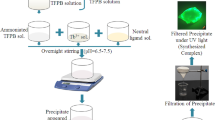Abstract
A new terbium 2-isopropylimidazole-4,5-dicarboxylic acid complex was prepared and incorporated into titanium dioxide matrix by mild sol–gel method. Then we fabricated a terbium luminescent hybrid material, which displayed striking green emission even in pure water. It was interesting to find that this target material exhibited highly selective and fast (1 s) quenching effect to F- compared with CH3COO-, Cl-, Br-, I-. We recognized that the hydrogen bonding interactions between fluoride and ligand resulted in the recognition process. More significantly, this hybrid titania material prepared under low temperature (80 °C) could be used in photodegradation of methyl orange in aqueous environment.
Similar content being viewed by others
References
A. Robertson, S. Shinkai, Cooperative binding in selective sensors: catalysts and actuators, Coord. Chem. Rev., 2000, 205, 57.
T. Michinobu, S. Shinoda, T. Nakanishi, J. P. Hill, K. Fujii, T. N. Player, H. Tsukube, K. Ariga, Langmuir monolayers of a cholesterol-armed cyclen complex that can control enantioselectivity of amino acid recognition by surface pressure, Phys. Chem. Chem. Phys., 2011, 13, 4895.
H. N. Kim, Z.-Q. Guo, W.-H. Zhu, J. Yoon, H. Tian, Recent progress on polymer-based fluorescent and colorimetric chemosensors, Chem. Soc. Rev., 2011, 40, 79.
K. H. Chalmers, M. Botta, D. Parker, Strategies to enhance signal intensity with paramagnetic fluorine-labelled lanthanide complexes as probes for F-19 magnetic resonance, Dalton Trans., 2011, 40, 904.
R. B. P. Elmes, T. Gunnlaugsson, Luminescence anion sensing via modulation of MLCT emission from a naphthalimide-Ru(ii)-polypyridyl complex, Tetrahedron Lett., 2010, 51, 4082.
J. C. G. Bunzli, C. Piguet, Taking advantage of luminescent lanthanide ions, Chem. Soc. Rev., 2005, 34, 1048.
C. M. G. dosSantos, P. B. Fernandez, S. E. Plush, J. P. Leonard, T. Gunnlaugsson, Lanthanide luminescent anion sensing: evidence of multiple anion recognition through hydrogen bonding and metal ion coordination, Chem. Commun., 2007, 3389.
D. Parker, Luminescent lanthanide sensors for pH, pO2 and selected anions, Coord. Chem. Rev., 2000, 205, 109.
P. Atkinson, Y. Bretonniere, D. Parker, Chemoselective signalling of selected phospho-anions using lanthanide luminescence, Chem. Commun., 2004, 438.
R. K. Mahajan, I. Kaur, R. Kaur, S. Uchida, A. Onimaru, S. Shinoda, H. Tsukube, Anion receptor functions of lanthanide tris(b-diketonate) complexes: naked eye detection and ion-selective electrode determination of Cl- anion, Chem. Commun., 2003, 2238.
H. Tsukube, A. Onimaru, S. Shinoda, Anion sensing with luminescent tris(b-diketonato)europium(iii) complexes and naked-eye detection of fluoride anion, Bull. Chem. Soc. Jpn., 2006, 79, 725.
T. Yamada, S. Shinoda, H. Tsukube, Anion sensing with luminescent lanthanide complexes of tris(2-pyridylmethyl)amines: pronounced effects of lanthanide center and ligand chirality on anion selectivity and sensitivity, Chem. Commun., 2002, 1218.
T. Gunnlaugsson, J. P. Leonard, Responsive lanthanide luminescent cyclen complexes: from switching/sensing to supramolecular architectures, Chem. Commun., 2005, 3114.
C. M. G. dosSantos, A. J. Harte, S. J. Quinn, T. Gunnlaugsson, Recent developments in the field of supramolecular lanthanide luminescent sensors and self-assemblies, Coord. Chem. Rev., 2008, 252, 2512.
N. S. Murray, S. P. Jarvis, T. Gunnlaugsson, Luminescent self-assembly formation on a gold surface observed by reversible “off–on” switching of Eu(iii) emission, Chem. Commun., 2009, 4959.
Q.-M. Wang, H. Tamiaki, Highly efficient and selective turn-off quenching of ligand-sensitized luminescence from europium imidazo[4,5-f]-1,10-phenanthroline complex by fluoride ion, J. Photochem. Photobiol., A, 2009, 206, 124.
C.-L. Tan, Q.-M. Wang, L.-J. Ma, Fluorescent-based Solid Sensor for HSO4- in Water, Photochem. Photobiol., 2010, 86, 1191.
Q.-M. Wang, C.-L. Tan, H.-Y. Chen, H. Tamiaki, A new fluoride luminescence quencher based on a nanostructured covalently bonded terbium hybrid material, J. Phys. Chem. C, 2010, 114, 13879.
C. Wang, B. Yan, J.-L. Liu, L. Guo, Photoactive Europium Hybrids of ß-Diketone-Modified Polysilsesquioxane Bridge Linking Si–O–B(Ti)–O Xerogels, Eur. J. Inorg. Chem., 2011, 879.
B. Yan, Q.-M. Wang, Two luminescent molecular hybrids composed of bridged Eu(iii)-ß-Diketone Chelates covalently trapped in silica and titanate gels, Cryst. Growth Des., 2008, 8, 1484.
L. Guo, B. Yan, New luminescent lanthanide centered Si–O–Ti organic–inorganic hybrid material using sulfoxide linkage, Inorg. Chem. Commun., 2010, 13, 358.
K. Binnemans, Lanthanide-based luminescent hybrid materials, Chem. Rev., 2009, 109, 4283.
M. Gratzel, Photoelectrochemical cells, Nature, 2001, 414, 338.
P. Wang, C. Klein, R. Humphry-Baker, S. M. Zakeeruddin, M. Gratzel, A high molar extinction coefficient sensitizer for stable dye-sensitized solar cells, J. Am. Chem. Soc., 2005, 127, 808.
M. H. Bartl, S. W. Boettcher, K. L. Frindell, G. D. Stucky, 3-D molecular assembly of function in titania-based composite material systems, Acc. Chem. Res., 2005, 38, 263.
W. K. Anderson, D. Bhattacharjee, D. M. Houston, Design, synthesis, antineoplastic activity, and chemical properities of bis(carbamate) derivatives of 4,5-bis(hydroxymethyl)imidazole, J. Med. Chem., 1989, 32, 119.
P. Liu, H.-R. Li, Y.-G. Wang, Europium complexes immobilization on titania via chemical modification of titanium alkoxide, J. Mater. Chem., 2008, 18, 737.
Author information
Authors and Affiliations
Corresponding author
Additional information
† Electronic supplementary information (ESI) available: Fluorescence spectra of the sensing material. See DOI: 10.1039/c2pp05380b
Rights and permissions
About this article
Cite this article
Zhou, Z., Wang, Q., Huo, S. et al. Luminescent terbium(iii) complex-based titania sensing material for fluoride and its photocatalytic properties. Photochem Photobiol Sci 11, 738–743 (2012). https://doi.org/10.1039/c2pp05380b
Received:
Accepted:
Published:
Issue Date:
DOI: https://doi.org/10.1039/c2pp05380b




